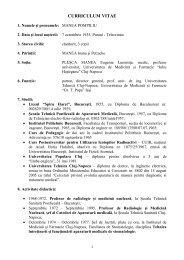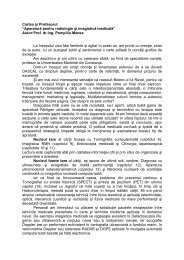Revista nr. 53-54 - Pompiliu Manea
Revista nr. 53-54 - Pompiliu Manea
Revista nr. 53-54 - Pompiliu Manea
- No tags were found...
You also want an ePaper? Increase the reach of your titles
YUMPU automatically turns print PDFs into web optimized ePapers that Google loves.
diode assemblies is characterized by a grate dynamic margin (a 16 bits digital output). Thatallows for getting high definition and high contrast images. Positioning and turning around of thesample are insured by a set of six high precision motorized micrometric manipulators.Automation, control and data acquisition are insured by an in-house software package. Thetomographic reconstruction for the cone-beam scanning is based on an optimizedimplementation of the modified Feldkamp algorithm. Using a parallelization technique onmultiprocessors workstations, experimental data consisting of large radiographic images(1220x1216 pixels) are processed for getting 3D reconstructions (1024x1024x1024 voxels) ofthe scanned sample. The most important characteristics of the X-Ray microtomographic systemare presented in Table 1.Stent scanningThree stents of two differenttypes have been scanned. The firstwas a straight Acculink(tm) selfexpandingcarotid stent (Fig. 2).Fig. 2 Acculink(tm) self expanding carotid stentThese laser cut stents are made of nitinol, which is a shape memory alloy, typicallycomposed of 50 to 56.6% nickel by weight. The nitinol superelasticity model is based onexperimental data of nitinol wires published by Pelton et al [9] and has already beenimplemented in the finite element solvers ABAQUS, ANSYS and LS_DYNA.Our X-Ray tomography results for the Acculink stent are presented in figure 3.Information about the scanning setup and parameters are also presented, in table 2.Table 2 Specifications about the stent scanning procedureX-Ray source Feinfocus nano-focus open X-ray tube 225 kV 15 WIrradiation parameters HV=90 kV, I=250 AX-Ray detector 1248x1248 Si flat panel, 14bits digital outputSpatial resolution 22 mNumber of projections 480Figure 3 shows a transversal and a longitudinal slice together with the 3D reconstructed imagein STL format. A detailed representation of one end of the stent is illustrated in figure 3 d. As thetriangulation of the stent surface is still visible, the next step towards an accurate representationof its geometry will be to extract the wire section and its longitudinal path. The wire section willthen be swept along the path and the smooth full 3D model reconstructed.(a)(b)18







